
With the heavy eating of Christmas behind us and New Year’s resolutions in the making, I thought it might be a good time to talk about training for mountain climbing! With only about 90 days until teams start leaving for Everest 2012, it is too late to start training but for the rest of us it is never too late!
When I was training for Everest, look I was told “Alan, you better be in the shape of your life!” Well they almost got it right, actually I needed to not only be in the shape of MY life, I needed to be in Everest Shape. With the clear disclaimer that I am not a doctor and everyone should visit their own Doc before entering any kind of Everest training program, let’s me provide some thoughts from my experiences.
My personal experiences with Everest have been difficult. I experienced a lung infection that stopped one climb, my body simply refused to acclimatize above 23,000’ on another, and I gave up mentally on my third. The vast majority of Everest climbers have full time jobs, full time families and cannot spend many hours everyday for a year to get in professional shape; so it becomes critical to make every workout count without hurting yourself. For my forth attempt and successful summit on Everest, my training mantra became: When you think you have given it your all, you have just started if you want to summit Everest.
If you ask 100 Everest climbers you might get 101 different answers on the way to train and I don’t think there is one ‘perfect’ approach. Some climbers will say cycling for 5 to 8 hours in the middle of the night is , others will prefer swimming and then some say weight training will get you there. And age does play a role.
But the common thread to all training is pushing yourself without injury and building mental discipline. There is no doubt that an Everest climb requires mental and physical endurance like few other sports. I consistently observe that competitive marathoners, tri-athletes and cyclists do well. However, all agree that training the mind is equally important as training the body.
The biggest issue you are dealing with is the lack of oxygen on Everest and the ability for your heart and lungs to get oxygen to your muscles. You cannot do much to acclimatize at low altitudes other than by putting in the training time before you arrive at base camp which will enable you to adjust as well your body allows to the changing oxygen density. The human body simply does not function well at high altitudes and especially above 8000m (26,300′). As you go higher, the barometric pressure decreases, although the air still contains 21% oxygen, every breath contains less molecules of oxygen.
There are companies that claim to help the acclimatization process through specially designed tents that simulate the reduced oxygen levels at higher elevations. I know some people who have used them for a few weeks before leaving for Everest and other climbs with success but remember that acclimatization only last a few weeks and your body will naturally adjust to the current altitude very quickly.
I believe it is a myth that you can train during the acclimatization process. Once at base camp, 17,500′, the altitude prevents building and your body actually begins to deteriorate regardless of your activity. So the bottom line is that a dedicated training program is your preparation.
Inside the Body
For an analytic approach to training, you can overload yourself with metrics trying to establish your base level of fitness. The professional or highly dedicated athlete will speak of VO2 max which is the maximum rate your body can move and use oxygen during periods of high stress or need. Another couple of terms are anaerobic threshold (AT) and lactate threshold which is when the chemical lactate acid begins to build in your blood stream and muscles thus preventing the body from functioning at full capacity. A qualified doctor or trainer can measure these levels through a series of treadmill and blood tests.
However, the essence of these measures and tests is to determine how to get red blood cells (e.g. oxygen) to your muscles and that is the key to climbing Everest. There is a third of the available oxygen on the summit of Everest thus making your heart, lungs and muscles cry out for more oxygen during the climb. Once exposed to high altitude the watery part of our blood (plasma) decreases to increase the density of the red blood cells thus making our blood thicker and harder for the heart to pump. The heart pumps faster and we breath harder to compensate and over time, this is corrected with more red blood cells.
Red blood cells carry oxygen to our muscles. By climbing higher than the previous day then returning to a lower altitude, your body creates these red blood cells. Without sufficient oxygen, our muscles get tired quickly and in addition, you eventually may suffer from cerebral edema (the brain swells) or pulmonary edema (fluid build-up in the lungs). The only cure is to get lower fast (1000′ minimum) but if you are high up on the mountain this is often impossible and death is the result.
The time honored and proven acclimatization process is where you “climb high, sleep low” to encourage the production of these red friends. This approach is to move slowly up the mountain (1000′ a day maximum) spending your days at a higher altitude than where you sleep up until your summit bid. Thus the many trips up and down Everest.
Inside the Mind

Mental toughness is a key to having a successful Everest experience. By this I don’t only mean the ability to push yourself physically but also the ability to manage your emotions and practice extreme patience. Like many sports, Everest is a long series of quick events with extreme boredom in between. Staying focused for 8 weeks is difficult at . Staying healthy the entire time is almost impossible.
Almost every climber will get sick – lower GI, upper respiratory, blisters, cough – you name it. These are almost always recoverable but if you give in mentally, you are done physically. These days, a team of doctors provided by EverestEr serves the climbing community on the south side for a very low price.
During all the physical training, take the opportunity to work on your mental side. During interval training push yourself at the point you want to stop. Do one more lunge after you reach your goal, push when you think you have nothing left. Visualize being on the mountain. Think through each part of the climb and where you will be stressed. Walk it through in your mind. If you can get in some incredibly long days like 16 hours of constant, tough physical activity, it will be money in the bank for you later on to build your endurance and mental discipline. As I said, when you think you have given it your all in training, you have just started if you want to summit Everest.
During the expedition, surround yourself with positive people and like minds. Don’t get drawn into the daily spats that will occur as a natural part of being in a compressed environment. But also, don’t isolate yourself. Take advantage of forming new and sometimes, lifelong, friendships with people who will believe in and support one another when the time comes. Never lose your sense of humor. And in the end, believe in yourself.
An Example Training Program
Training before you get to Everest must begin six to 12 months with a focused, intense and balanced exercise program – after a check up from your Doc. In my mind there are three major phases: foundation, aerobic/strength and peaking. The major groups to work on include: heart, lungs, abs, lower back muscles, thighs and calves. Oh; and mind.
Foundation
Having a solid foundation is important to build upon as well as to reduce the risk of injury. Most Everest climbers will already have a good foundation but it should include being at the correct weight or body mass index, having reasonable overall body strength and an ability to exercise aerobically without severely struggling. An unscientific measure could include running five 10 minutes miles at relative ease. Also some form of strength testing such as doing 20 reps of leg lunges for 3 sets. If not there already, take three months to reach this point.
Aerobic/Strength Training
The next phase can take six months or longer. Again, a check-in with your Doc might in order at this point. I have found interval training the overall approach to building heart and lungs. Simply put this involves a relatively intense run at fast then slow rates after a sufficient warm-up followed by a cool-down period. Using the simple max heart rate measure of 220-your age = max heart rate, run at 90% of you max for 2 to 3 minutes (or as long as you can in the beginning), then slow until your heart reaches 60% of your max then speed up again. Repeat for five to ten times and cool down. Interval training will stress your heart and lungs to provide more oxygen in high demand moments – just what you need on Everest. Combined with a long e.g. 8 miles run once a week for overall endurance, this will increase your aerobic capacity.
Strength is just as important. Most Everest climbers are not body building champs but rather slight and well balanced. The strength comes in the core (abs and lower back) and legs. The core is important for carrying heavy packs and the legs for climbing and carrying the heavy loads especially when exhausted. There are many exercises that can build these muscles but my favorites are lunges, sit-ups and step ups on a two foot bench. This last one has the added benefit of working your lungs and heart at the same time.
While I like interval training, very long days (8+ hours) with a heavy pack (40 pounds plus) will accomplish much of these same results but only if you push yourself hard throughout the training.
Peaking
The last phase is peaking. If you have been dedicated to this program, eating a well balanced diet, maintaining a good weight, then you will be feeling pretty good a few months before leaving for Everest. Spend the last weeks tuning weak areas – calves are notorious for being short-changed, running more long distance to build stamina versus aerobic capacity and staying in a high level of overall fitness. Don’t worry about training to the very last day if you have been focused throughout the previous months.
Finally, I cannot emphasize the need to be at your healthy body weight. You may read that people lose weight on Everest, and that is true, so they add a few pounds before leaving home. Don’t. Go in at your ideal weight and work hard to maintain it it through proper eating throughout the expedition. Extra body weight makes your heart and lungs work harder, wastes effort and is generally .
Remember to take adequate rest days throughout your training. Muscles need at least 24 hours to rebuild after a tough workout. Intersperse fun activities. Don’t do the same routine week in week out. Cycle instead of running, play basketball instead of intervals, get a workout buddy or a trainer to keep you honest and motivated.
If all this seems like a lot of work, it is. But I can tell you that when you are carrying a heavy pack at 22,000’ on an icy Lhotse Face, those days of huffing and sweating will be a pleasant memory. Visit my training page for a suggested schedule for this program.
Classifying Everest
Being ready for Everest means knowing the route and setting your own expectations. One measure of climbing difficulty is the rating and climbing has a terminology of it’s own. You read that she just redpointed a 5.12c and wonder if this was something from NASA, or Congress. I have seen Everest described as a simple “walk-up” meaning that no actual climbing is involved so I thought a quick review of what defines climbing might be helpful. I will use the South Col route as the example but obviously with other routes, you can experience much more difficult terrain.
One point to keep in mind that the base definition of “technical” often means that climbers must use crampons and an ice axe. This implies skills with snow travel, crevasse rescue and self-arrest techniques – all of which are needed for a safe Everest climb from base camp to the summit; and back. There are many ways of grading climbs but I used the Yosemite Decimal System (YDS) since many people are familiar with it. However using the Alpine Grade might be more beneficial. I will discuss this at the end.
A final preamble item, one word: altitude. This makes all the difference and more complicated with snow and ice. Walking on flat ground at 20,000′ is vastly different than walking on flat ground at sea level – obviously. Please keep this in mind as you read these descriptions relative to Everest.
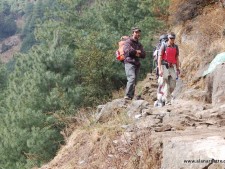
Class 1:
Trail hiking. Mostly groomed trails that are easy to find in the summer and relatively smooth. You walk upright without using your hands for balance. It can be a little steep at times.
The trek to Everest Base Camp is mostly class 1 intermixed with brief class 2 sections.
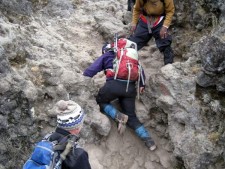
Class 2:
Simple off-trail hiking. Some scrambling may be required on the route with an occasional use of the hands for balance. Down climbing is straightforward.
Kala Patar at 18,192′ (remember altitude) would be a class 2 route with some scrambling required near the summit using hands for balance.
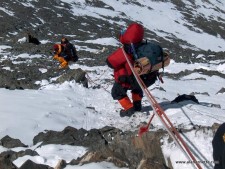
Class 3:
This is actual “climbing” since you frequently scramble using your hands. Handholds are easy to find. You can down climb facing out from the route.
This picture show climbers at the top of the Geneva Spur at 26,200′ using the fixed rope. Some of the route from Camp 2 at the base of the Lhotse Face to the South Summit is class 3 but mostly class 2 via the fixed ropes.
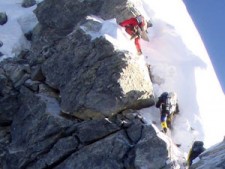
Class 4:
Simple climbing, with exposure. You must look for handholds and test them that they will hold you before using. You use your upper body muscles. A rope is often used for down climbing (rappelling). Falls may result in serious injury or even death.
Climbing a ladder is considered class 4. Some climbers feel that class 4 is really entry class 5. Confused yet?
I would rate the Khumbu Icefall overall as class 4 due to the crevasse danger and the need to use hands and feet on ladders and climbing over ice formations. However, a large part of the Icefall is on somewhat smooth terrain which would be rated class 2, however at 19,000′. Remember the most difficult section drives the overall rating.
Sections of the Lhotse Face and Cornice Traverse would be class 4 due to the exposure. The Hillary Step is class 4 at 28,740′.
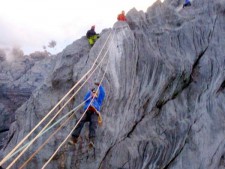
Class 5:
True technical climbing normally using ropes, carabiners, anchors (protection), harness, etc. Climbers often belay one another. In the winter you use an ice axe and crampons. There are sub-ratings for class 5 ranging from 5.0 for “easy” climbs with frequent hand and foot holds to 5.13 that has smooth surfaces, narrow cracks and vertical rock on an overhang.
With the route fixed, almost none of the South Col route meets these definitions even though an axe and crampons are used. However, obviously, there are much more difficult routes on Everest that significantly exceed the South Col and Northeast Ridge difficulty.
All of this discussion uses the Yosemite Decimal System which was designed primarily for rock climbing. There are other systems for alpine climbing, ice climbing and alternative rating systems from the European rating system and the Alaskan rating system. See this link for more information.
So no matter how you rate Everest, it is a lot of fun and test all a climber’s skills. This video shows me rappelling in the Khumbu Icefall in 2008.
My 2011 Training and Preparations
I summited Everest at 5:00 AM on May 21, 2011. For a complete overview, download my Everest 2011 Trip report. Here are the highlights wrt training.
I was incredibly pleased with my personal performance and climb times, especially on summit night where I climbed from the South Col to the summit in 7:40 and returned in 3:20. This was quite a difference from my previous three attempts where I turned back due to fatigue or illness around 27,000′ or below the Balcony. I climbed with International Mountain Guides’ Classic team using only Sherpas guides. I can identify six areas that made a huge difference for 2011. Obviously these are my thoughts and don’t apply to everyone.
PHYSICAL PREPARATION : My fitness was at a different level than on the previous attempts even though I was 9 years older. In the previous 18 months, I climbed over 30 14,000 Colorado and California mountains with 30-50lb packs. Also climbed Vinson and Aconcagua in the prior 4 months. I lost about 10 pounds before coming to EBC then lost another 15 pounds (mostly muscle mass, which is usual) in the early expedition time; which was a bit too much taking me to 165lbs. I am 5′ 10″.
MENTAL TOUGHNESS: In looking back at my other climbs, I hit my mental wall way before my physical wall and quit too soon. I never understood how much reserves my body really had. Again, many people talk about mental toughness but a simple note one time from Clive Jones, a climbing friend, and discussing directly with Jim Davidson, a dear climbing friend, about his Rainier tragedy showed me how far one can push their body if the mind is willing.
So in the last few years, I have been working on mental toughness. I went for climbs in the dead of winter leaving home at midnight and climbing to dawn in high winds and sub-zero temperatures with all my summit gear on. I went for long hikes in the rain. And I always pushed myself when I wanted to stop. When the time came on Everest to push my body, my mind was willing.
CLIMBING PLANS: I thought through the way to climb Everest. For example, I always stayed at Camp 1 around 19,500? on each rotation based on suggestions. The standard program is to stay there once, but I found by staying there each rotation, I was able to manage my energy more evenly and not wear myself out trying to go from BC to C2 in one big push. Also, I pushed the envelope a bit by staying at Camp 2 three nights instead of the normal two on the first rotation.
Reviewing my own prior performance, I changed my supplemental oxygen plan. I was very glad that IMG used the TopOut mask instead of the old Posix one that leaked 50% of the air. Also, I used an extra bottle of oxygen on the final summit push from the South Col. These two factors, mask and O’s, allowed me to climb using 4lpm flow from Col to Summit and back instead of a leaky 2lpm in my previous climbs – this was a huge difference.
PACE: Thanks to advice from many people (John Dahlem) and my own experience of pushing too hard and succumbing to the pressure of the guide clock; I climbed at a pace I was comfortable with. IMG never put any pressure on me to meet climb times between camps and Kami’s favorite word was “slowly”. Obviously I knew that I needed to be able to go fast through dangerous sections or if the weather turned but allowing my body to acclimatize naturally was a huge advantage and I did not waste energy competing against the clock or other climbers.
Also when I got sick, I gave myself permission to be sick and get well. This was critical in that I did not stress over schedules and got the necessary rest, food and hydration my body so desperately needed. Allowing myself to recover enabled me to enter the final acclimatization rotations strong. A final factor in pace was that I employed every trick and technique I new throughout the expedition from sleeping to gear to eating, drinking, foot placement (simple, small steps), clothing layers, attitude, who I hung out with, etc. One proof of how it worked was that I never lost my appetite, rare for me.
PERSONAL SHERPA: This should be no surprise to anyone who followed along. Kami (Ang Chhiring Sherpa – Pangboche) was a perfect match for me. At age 46 with 12 Everest summits, K2, Cho Oyu, Ama Dablam, and many other climbs, he had the maturity, experience and personality I needed. We spent time getting to know each other with local climbs, shared tents, meals and became friends. He understood the importance of this climb to me in spite of the culture and language difference. His gentle touch yet strong focus was what the Doctor ordered. He inspired confidence as did many of the IMG Personal Sherpas.
PURPOSE: But the biggest difference was the inspiration and motivation that came from watching my mom struggle with Alzheimer’s. She did it with class, dignity and humor. She never let on how much it hurt. Her strength and courage kept me going every time I felt weak – physically or mentally. In addition, knowing that there were millions going through the same struggle inspired me knowing that many people were watching me. I simply could not let them down. So perhaps the pace went a little quicker.
OK, that’s my thoughts on training and what to expect. Prepare your body, prepare your mind and go have fun!
Climb On!
Alan
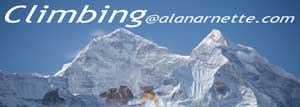

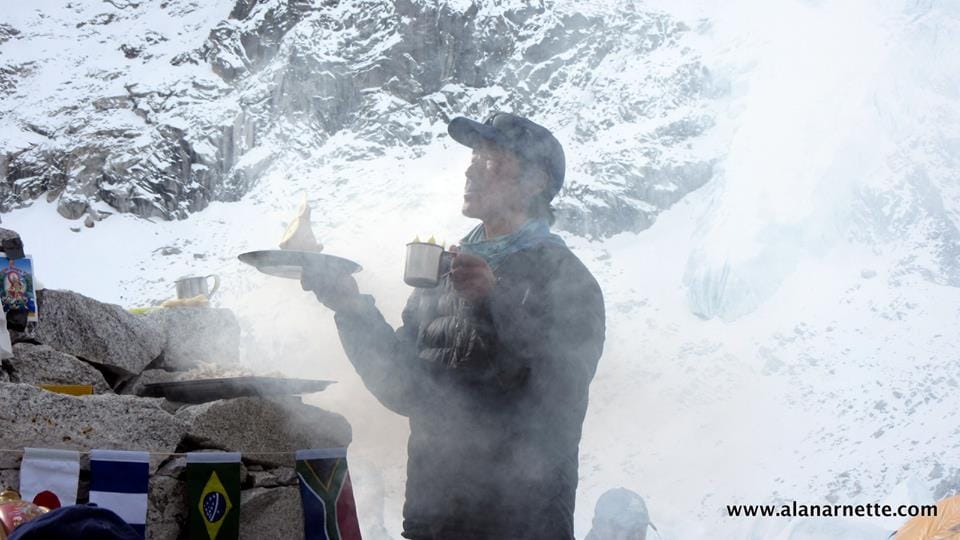
14 thoughts on “Getting in “Everest Shape””
Hi Allan,
After reading all previous notes. Over and above all, I was profoundly impressed with the sincere humility the reader is left with.
Terrific post Alan. I think you did a great job explaining the physical as well as mental aspects of your training. And thanks again for your e-mail about your climbs on Mont Blanc. I will draw much inspiration from your accomplishments when I’m climbing in the Alps again next summer.
All the best,
Ken
Thanks everyone for your comments on this post. I learned the hard way to climb Everest and hope my experience can help others as they out difficult goals. For those of you planning or about to embark on a climb – be safe and Climb on!
Alan,
What great information for climbers that have hopes of conquering themselves rather than a mountain. I was so impressed with your ability to learn from each climb, and in your very special humble way, educate us with important content. I will re-read the information many times because there is so much to digest. All of us from the climbing community thank you for your contribution.
Thanks for all you have done to make the world a better place.
Mark Rickert
Alan…super job as usual and hard to believe another Everest Season is almost here….several close friends going back this year…Bill Burke, Robert Kay, etc. I keep adding goodies from your list to mine… “Everest from the Rookies” and continue to expand my equipment and packing list…use any of my info that you want in your very informative information.
“Climb on one day at a time,”
John
🙂
Alan, I’ve truly enjoyed your posts over the last year as I’ve prepped for Aconcagua. I’m posting this from the gate at Miami Intl as we ready to board for our red eye to South America. Thanks for all of your insight and inspiration. And thanks, too, for the awareness you’re bringing to Alzheimer’s. It’s in the process of claiming my grandfather, but with continued effort, this hopefully will be a disease we can eventually cure.
Alan, this is great stuff for anyone planning an Everest climb! Well written and very well documented. Mental toughness cannot be overemphasized. One thing Kristine and I did different from our normal mountain routine of climbing, running, skinning, etc year-round is hit the gym to build some muscle mass on our thin bodies. I think this helped us out a bit when we inevitably lost weight being at altitude for so long and eating our meager meals.
Happy holidays!
Brandon
This is great stuff- one of the challenges I am facing as I am training for my Mt. Adams climb in 2012 is how to best train. Like you said above, there are 100 different training methods and ideas out there, and I’ve read lots of them. Your guidance is great!
Alan, I liked the “leave at 12 midnight and push yourself when the weather was at its worst. It’s how I trained myself to play competitive golf- but not at night of course- just in the rain, and snow. I’m currently working out for my trip to Long’s. I’ll remember that “one more rep” or one more step on the stair-master! Great climb, as always- congratulations on your accomplishments on and off the mountain.
TC
Very well said Alan. Well researched and articulated. The ‘mental’ (psychological) is certainly the key to success. Being physically prepared is obviously an absolute, keeping your spirit and drive strong for 9 weeks is vital. You must know why you are there. Pushing yourself training 10-12-14 hours in cold and crazy conditions works like nothing else. When climbing that Lhotse Face in 100km winds you need all the ‘out of your comfort zone’ preparation you can muster.
I was lucky to summit Everest on my 1st attempt in 2010 with IMG. My first visit though was 1969 when I spent a month alone trekking to Everest’s base.
Everest is a great mountain and a great life challenge. Take it seriously, prepare, and regardly whether you summit or not, it will be a great success.
Alan… this is beautifully written.. comprehensive… detailed… valuable…. and thank you for giving credit to your Sherpa… sometimes they do so much with so little acknowledgment. I’ve followed you every step… and now there are new “mountains” to summit. Climb On !!!
Fantastic post filled with real information; very inspirational. Thanks Alan!
I can’t even think of the right words for your extraordinary mental toughness and how much work went into that aspect of your training. Happy Holidays!
A really great post as always Alan, particularly valuable for someone making their second Everest attempt next year! I’d agree that so much can be learnt irrespective of if the summit is reached or not. Best wishes, Becky
Comments are closed.